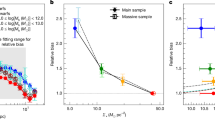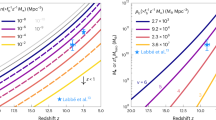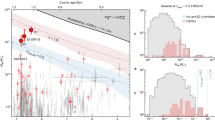Abstract
THE theory of biased galaxy formation with cold dark matter (CDM) is presently the most successful attempt to reproduce the distribution of galaxies in the Universe1–6, permitting a reconciliation of the observed low value of the cosmological density parameter ω0 ≤ 0.2 with the value of unity predicted by inflation. Specific tests of the bias hypothesis, namely that galaxies are more clustered than the mass1,2,4, however, have not yet led to definitive conclusions. Here we show that a systematic luminosity segregation effect in the clustering of galaxies is expected and provides an unambiguous test of the biased galaxy formation theory. We examine in detail how the clustering of galaxies correlates with their luminosity, using different biased models and numerical simulations5–7. We find that a strong effect is expected at luminosities larger than L* the characteristic luminosity of galaxies and that the amplitude of the predicted effect at these luminosities agrees with observations8. At luminosities fainter than L* however, strong limits have been put on this segregation effect9. These limits are incompatible with any biased CDM theory in which the bias parameter bb for bright galaxies is greater than 1.5 on large scales.
This is a preview of subscription content, access via your institution
Access options
Subscribe to this journal
Receive 51 print issues and online access
$199.00 per year
only $3.90 per issue
Buy this article
- Purchase on SpringerLink
- Instant access to full article PDF
Prices may be subject to local taxes which are calculated during checkout
Similar content being viewed by others
References
Davis, M., Efstathiou, G., Frenk, C. S. & White, S. D. M. Astrophys. J. 292, 371–394 (1985).
Rees, M. J. Mon. Not R. astr. Soc. 213, 75p–81p (1985).
Dekel, A. & Silk, J. Astrophys. J. 303, 39–55 (1986).
Dekel, A. & Rees, M. J. Nature 326, 455–462 (1987).
Frenk, C. S., White, S. D. M., Efstathiou, G. & Davis, M. Nature 317, 595–597 (1985).
White, S. D. M., Davis, M., Efstathiou, G. & Frenk, C. S. Nature 330, 451–453 (1987).
Frenk, C. S., White, S. D. M., Davis, M. & Efstathiou, G. Astrophys. J. 327, 507–525 (1988).
Hamilton, A. J. S. Astrophys. J. 331, L59–L62 (1988).
Alimi, J.-M., Valls-Gabaud, D. & Blanchard, A. Astr. Astrophys. 206, L11–L14 (1988).
Blumenthal, G. R., Faber, S. M., Primack, J. R. & Rees, M. J. Nature 311, 517–525 (1984).
Schaeffer, R. Astr. Astrophys. 180, L5–L8 (1987).
West, M. J. & Richstone, D. O. Astrophys. J. 335, 532–541 (1988).
Bardeen, J. M., Bond, J. R., Kaiser, N. & Szalay, A. S. Astrophys. J. 304, 15–61 (1986).
Davis, M., Huchra, J., Latham, D. W. & Tonry, J. Astrophys. J. 253, 423–445 (1982).
Einasto, J., Klypin, A. & Saar, E. Mon. Not. R. astr. Soc. 219, 457–478 (1986).
Phillipps, S. & Shanks, T. Mon. Not. R astr. Soc. 229, 621–626 (1987).
Einasto, M. Mon. Not. R astr. Soc. 234, 37–50 (1988).
Davis, M. & Djorgovski, S. Astrophys. J. 299, 15–20 (1985).
Bothun, G. D., Beers, T. G., Mould, J. R. & Huchra, J. P. Astrophys. J. 308, 510–529 (1986).
Tully, B. Astr. J. 96, 73–80 (1988).
Davis, M., Meiksin, A., Strauss, M. A., Da Costa, L. N. & Yahil, A. Astrophys. J. 333, L9–L12 (1988).
Davis, M., Tully, B. & White, S. D. M. Astrophys. J. 333, L45–L49 (1988).
Peacock, J. A. & Heavens, A. F. Mon. Not. R astr. Soc. 217, 805–820 (1985).
White, S. D. M. in The Early Universe (eds Unruh, W. G. & Semenoff, G. W.) 239–260 (Reidel, Dordrecht, 1988).
Carlberg, R. G. & Couchman, H. M. P. Astrophys. J. 340, 47–68 (1989).
Davis, M. & Peebles, P. J. E. Astrophys. J. 267, 465–482 (1983).
Press, W. H. & Schechter, P. Astrophys. J. 187, 425–438 (1974).
Schaeffer, R. & Silk, J. Astrophys. J. 292, 319–329 (1985).
Blanchard, A. & Alimi, J.-M. Astr. Astrophys. 203, L1–L4 (1988).
Bahcall, N. A. & Soneira, R. M. Astrophys. J. 270, 20–38 (1983).
Lynden-Bell, D. et al. Astrophys. J. 326, 50–62 (1988).
Sutherland, W. Mon. Not R astr. Soc. 234, 159–172 (1988).
Author information
Authors and Affiliations
Rights and permissions
About this article
Cite this article
Valls-Gabaud, D., Alimi, JM. & Blanchard, A. Luminosity segregation as a constraint on the theory of biased galaxy formation. Nature 341, 215–217 (1989). https://doi.org/10.1038/341215a0
Received:
Accepted:
Issue date:
DOI: https://doi.org/10.1038/341215a0



